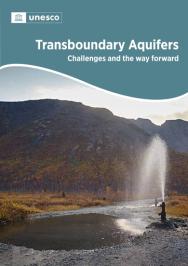News
Launch of Transboundary Water Cooperation Coalition to foster peace and sustainable development
Few arrangements target aquifers specifically
The most recent map of transboundary aquifers dates from 2021. This map has been prepared by the International Groundwater Resources Assessment Centre (IGRAC), which operates under the auspices of UNESCO, with financial support from the Government of the Netherlands. This is the third map of transboundary aquifers produced by IGRAC since 2009, as transboundary aquifers are still being identified and better delineated. There were 468 known transboundary aquifers in 2021.
Globally, only a handful of arrangements have been developed for aquifers specifically. They range from agreements governing cooperation over large aquifer systems spanning many countries to the cooperative management of very local problems linked to groundwater.
There are only a handful of cases worldwide of interstate agreements on transboundary aquifers in force, namely: the Genevese aquifer (France, Switzerland), the Northwestern Sahara Aquifer System (Algeria, Libya, Tunisia), the Nubian Sandstone Aquifer System (Chad, Egypt, Libya, Sudan), the Guarani Aquifer (Argentina, Brazil, Paraguay, Uruguay), the Saq-Disi Aquifer (Jordan, Saudi Arabia) and the Calcaires Carbonifères (Belgium, France).
Frequently, transboundary aquifers are part of a broader water cooperation agreement that has been developed for transboundary river basins. These broader agreements may apply to transboundary groundwater to a varying extent. They do not necessarily consider the aquifer as a whole, as the area covered by surface water basins rarely aligns with the underlying groundwater systems.
The situation varies among regions
Europe and North America are the most advanced for operational arrangements concerning transboundary aquifers, with 24 out of 36 countries reporting that operational arrangements cover 70% or more of their transboundary aquifer area.
On the other hand, operational arrangements cover only 30% or less of the transboundary aquifer area for most countries in Central, Eastern, Southern and Southeastern Asia, Latin America and the Caribbean, Northern Africa, and Western Asia.
The situation in Sub-Saharan Africa presents is intermediate, although the majority of countries still report that operational arrangements for transboundary aquifers are lacking, or that they have encountered difficulties in obtaining the requisite aquifer data.

Slow progress
UNESCO and the United Nations Economic Commission for Europe (UNECE) are co-custodians of Sustainable Development Goal indicator 6.5.2, which means that they are responsible for monitoring how cooperation between countries over transboundary basins is progressing[1] . The latest report was published in 2021. It reveals that progress is proving to be too slow. The pace would have to more than double to achieve SDG target 6.5 on Integrated Water Resources Management at all levels[2].
There is, thus, a clear need to accelerate progress on transboundary water cooperation. This is all the more urgent, in that water resources are becoming increasingly stressed as a consequence of climate change, over-use and pollution. We not only need to sustain current efforts to manage transboundary waters equitably and bridge the knowledge gap. We also need to step up these efforts, in order to mitigate future risks to our water supply which could lead to conflict.
As the international community prepares for the first United Nations’ Water Conference in 46 years, which is taking place in New York in March 2023, now is the time to place transboundary water cooperation at the forefront of the global water agenda. One of the interactive dialogues at this conference will be devoted to the topic of water for cooperation. The March conference will offer a golden opportunity for governments, the private sector and other stakeholders to commit voluntarily to accelerating progress on transboundary water cooperation.
Members of the Coalition
The Transboundary Water Cooperation Coalition is a multistakeholder partnership which has set itself the objective of highlighting the critical importance of cooperating over shared water resources at a time when it has become imperative to ensure water security and sustainable development.
To date, the following countries, United Nations agencies and international institutions have joined the coalition:
Dominican Republic, Estonia, Finland, France, Germany, Hungary, Kazakhstan, Morocco, Namibia, The Netherlands, Panama, Senegal, Slovenia, Switzerland, Uganda, Inter-American Development Bank, Organization of American States, World Bank, Global Environment Facility, Economic Commission for Europe (UNECE), United Nations Educational, Scientific and Cultural Organization (UNESCO), United Nations Environment Programme (UNEP), United Nations Development Programme (UNDP), Economic and Social Commission for Western Asia (ESCWA), United Nations Capital Development Fund (UNCDF), International Groundwater Resources Assessment Centre (IGRAC), Centro Regional para la Gestión de Aguas Subterráneas de América Latina y el Caribe (CeReGAS), Global Water Partnership (GWP), IHE Delft Institute for Water Education, International Network of Basin Organizations (INBO), Stockholm International Water Institute (SIWI), International Union for Conservation of Nature (IUCN), Geneva Water Hub, EcoPeace Middle East, and the University of Kinshasa.
Timeline
The Coalition will promote transboundary water cooperation until the UN 2023 Water Conference, then take stock of the effectiveness of its work. It aims to continue fostering transboundary water cooperation until the end of the 2030 Agenda for Sustainable Development.
Footnotes
1 - SDG Indicator 6.5.2: proportion of transboundary basin area with an operational arrangement for water cooperation.
2- SDG Target 6.5: By 2030, implement integrated water resources management at all levels, including through transboundary cooperation as appropriate.












